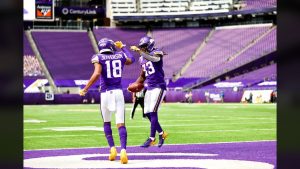What Can the Minnesota Vikings Learn From This Postseason?

The Minnesota Vikings may not be participating in the NFL playoffs this year, but that doesn’t mean that they and their fans can’t take note of a few things that we’ve seen transpire. The NFL is a game without any cheat codes. However, it does drop little hints here and there that show us how the best teams operate. Here are a few notes that I’ve taken.
Wins are, for the last time, NOT a QB Stat
Yes, the Vikings finished 7-9 with Kirk Cousins under center this year. While it’s easy to blame him for this season being lost, it’s time to stop. In fact, it never should have happened. Tom Brady is playing in the Super Bowl after throwing three interceptions in an NFC Championship Game that he should have lost. It’s a team sport, and the entire team tells the story, not just one player.
Russell Wilson lost to Jared Goff in the wild card round. Does that mean Goff is a better quarterback/winner/clutch player than Wilson? Of course not. It means that Goff had a better team around him on both sides of the ball.
Does the fact that Deshaun Watson missed the playoffs mean he isn’t one of the top 14 quarterbacks in the league? Based on so many Vikings fans expressing a desire to trade for him and his overall impact on any game, I’d think not. In fact, I don’t think it’s crazy to think he’s top five. Stop blaming Kirk Cousins.
Play to Strengths
Sometimes, the best teams don’t always have the best players. They just know their players strengths and stick with it. At times this year, the Minnesota Vikings seemed to forget that when they’re at their best, they use the run to create passing opportunities.
One game specifically that comes to mind was week three against Tennessee. The Vikings went up 24-12 with eight minutes left in the third, so it’d make sense to feed Dalvin Cook, keep the ball, and run some clock, right?
Well, the Vikings didn’t do that. On their final 25 plays, Cook touched the ball just eight times. Five of those touches were on their scoring drive to put them back up 30-25 while four of his carries were for over five yard gains. Minnesota would have won this game if they stuck to their strengths.
If you look at the Chiefs, they know exactly where their strength lies: Tyreek Hill and Travis Kelce. In the AFC Championship Game, the two of them combined for an astonishing 26 targets of Mahomes’ 38 total passes. Over the course of the regular season, over 44% of the Chiefs’ targets went to these two players, per Pro-Football-Reference.
A Good Backfield Doesn’t Solve Everything
The NFC Championship Game is a perfect example of this. Aaron Jones, Jamaal Williams, and AJ Dillon are one of the better backfield duos in the league. Granted, Jones was hurt for a lot of this game. This team has found plenty of success with Dillon, though.
The Packers offensive line is usually one of the best in the league as well, but it was rendered vulnerable after the loss of LT David Bakhtiari. Because of that, when the Packers went up against Tampa Bay’s incredible defensive front, the result was a measly 67 rushing yards and five sacks of Aaron Rodgers.
Minnesota may have a great backfield anchored by Dalvin Cook, but that by itself is not enough to create a winning team. PFF ranked the Vikings’ offensive line as the 26th best in the league. It’s not a secret why. Kirk Cousins was sacked 39 times, good(?) for sixth most in the league. Patrick Mahomes, on the other hand, was sacked 22 times while Tom Brady was taken down just 21 times.
A Secondary is a Fine Wine
It gets better with age (as long as they aren’t on the wrong side of 30). The Minnesota Vikings secondary may not have been that impressive for much of this season. However, much of that is simply because Jeff Gladney, Cameron Dantzler, and Kris Boyd, among others weren’t ready for their roles. That’s OK. Next season starts fresh, and these experiences from 2020 will only enhance their progression going into 2021.
It wasn’t that long ago that the Packers had one of the worst pass defenses in the NFL, and this year, they gave up the seventh fewest passing yards and eleventh fewest passing touchdowns. Their secondary is anchored by young guns that have progressed into two of the best defenders in the league: Jaire Alexander and Adrian Amos. There is no reason that the Vikings young secondary can’t develop into a similar unit in the coming years.
Closing Thoughts
It may seem like the Vikings have a lot of work to do this offseason. If you really think about it, though, it’s not that much. Both lines need work, but outside of that, the Vikings already have a blueprint for winning games.
If they stick to what brought them success in the middle portion of 2020, there is no reason for this team to not be a playoff contender. Dalvin Cook is the engine. Kirk Cousins, Adam Thielen, and Justin Jefferson provide support. The secondary will be better. If the Vikings can just get the trenches figured out, 2021 should be a bright year for Minnesota.
